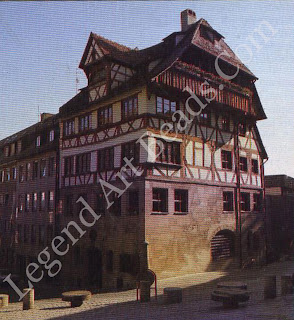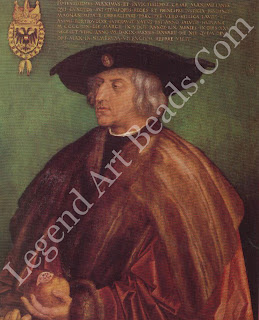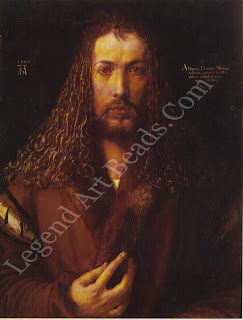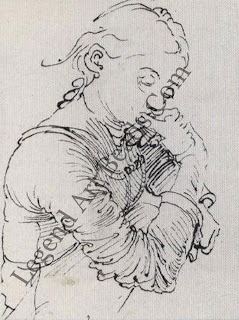Introduction to Albrecht Durer
Albrecht
Diirer was the greatest artist of the Northern Renaissance. He experimented in
many media, and is as well-known for his delicate watercolors of animal and
plant life as for the dramatic woodcuts and exquisite engravings on religious
themes which brought him fame in his own time. His art is a blend of Northern
and Southern traditions, profoundly influenced by the Venetian painting he saw
during his visits to the city.
Durer
was an independent man, proud of his appearance and very sure of his talent.
Intelligent and cultured, he mixed with humanists and scholars, while his
patrons included the Holy Roman Emperor Maximilian I. A religious man
throughout his life, in later years he became increasingly preoccupied with the
advent of the Lutheran Reformation. He died in 1528 and was buried in his home
town of Nuremberg.
Albrecht Durer was born on 21 May
1471, in the south German city of Nuremberg. His father, a goldsmith from
Hungary, had married Barbara Holper, his master's daughter, who went on to bear
him eighteen children, of which Albrecht was the third.
 As a child, Durer attended a local
Latin school, where he first met Willibald Pirckheimer, a young nobleman, who
was to become a famous Humanist scholar and Dtirer's lifelong friend and
correspondent. For three years after leaving school [hirer followed custom and
studied the goldsmith's trade in his father's workshop. Already he displayed
signs of his wondrous artistic talent. In the memoir he wrote shortly before
his death, Darer recalled: 'My father took special pleasure in me, for he saw
that I was eager to know how to do things and so he taught me the goldsmith's
trade, and though I could do that work as neatly as you could wish, my heart
was more for painting. I raised the whole question with my father, and he was
far from happy about it, regretting all the time wasted, but just the same he
gave in'. the Nuremberg painter Michael Wolgemut, master of the old late
medieval style.
As a child, Durer attended a local
Latin school, where he first met Willibald Pirckheimer, a young nobleman, who
was to become a famous Humanist scholar and Dtirer's lifelong friend and
correspondent. For three years after leaving school [hirer followed custom and
studied the goldsmith's trade in his father's workshop. Already he displayed
signs of his wondrous artistic talent. In the memoir he wrote shortly before
his death, Darer recalled: 'My father took special pleasure in me, for he saw
that I was eager to know how to do things and so he taught me the goldsmith's
trade, and though I could do that work as neatly as you could wish, my heart
was more for painting. I raised the whole question with my father, and he was
far from happy about it, regretting all the time wasted, but just the same he
gave in'. the Nuremberg painter Michael Wolgemut, master of the old late
medieval style.
In 1490, at three years in Wolgemut's studio, Dtirer set off
the traditional German 'bachelor's year', a pen of wandering from city to city
when life could explored before settling down and accepti family
responsibilities.
He travelled through much of what was
the Holy Roman Empire, and after two arrived in Colmar in Alsace, now a Germs
speaking part of France. There he had hoped meet Martin Schongauer, the
greatest Germ engraver of the previous generatic Unfortunately, Schongauer had
died only Mont before Durer's arrival. Nonetheless, he stay with the dead
master's brother and no dot learned from him some of the technical secrets was
later to use in his own work. Darer al worked for publishers in Basel and
Strasboui designing woodcut illustrations for Bibles other books.

In 1493, his father arranged a
marriage for hi with the daughter of a local coppersmith, a 8 named Agnes Frey.
Darer sent home a marvello painted portrait of himself, then aged twenty two
which is the first independent self-portrait painted only for the artist's
personal satisfaction in the whole of European art. In it he appears a handsome
if unusual looking youth, adorned in what today would be called fashionable,
flamboyant clothes, proud of his long blond tresses and even prouder of his
painterly skill. Darer returned to Nuremberg to be married in the spring of
1494. We know little of his wife's personality, though Pirckheimer complained
in later years that she was 'nagging, shrewish, and greedy'.
Within months of
his marriage Durer left his wife in Nuremberg and set off on his first journey
to Italy, using money borrowed from Pirckheimer's family.
JOURNEY TO ITALY
There was plague in Nuremberg at the
time and this may have been the young artist's motive for leaving the city.
Whatever the reason, there can be little doubt that Durer was powerfully
attracted by what he must have heard, during his earlier travels, of the feats
of the new Italian masters of painting and drawing. German artists, he said,
were 'unconscious as a wild, uncut tree', whereas the Italians had rediscovered two hundred years ago the art revered by the Greeks and Romans'.
There were no carriage facilities for
long-distance travel at that time and the journey over the Alps on horseback
must have been a perilous one. On his way Durer recorded his impression of the
mountain scenery in a series of brilliant watercolors. In Pavia he visited
Pirckheimer, who was completing his studies at the great university there, and
through him Outer came to know of the work of the Italian Humanists, whose
scientific curiosity and independence of mind appealed to him strongly.
The highlight of his journey was
Venice. With his unquenchable thirst for knowledge and his customary diligence,
Durer set himself to learn all that contemporary Italian masters could teach
him. He studied the science of perspective and the portrayal of the nude. He
copied the works of Mantegna and other engravers, and argued over the various
theories of art with the sociable circle of Venetian painters.
When he returned home the following
year he brought with him the rudiments of the Italian Renaissance and the
ambition to transplant them to his native northern soil. He made a living from
his woodcuts and engravings, often single sheet designs which his wife and
mother would hawk in the public markets and fairs, and which were carried all
over Europe by the town's travelling merchants.
These were tumultuous years in
central Europe. Many preachers foretold the world would end in the year 1500.
These feelings of doom were brilliantly summed up in Durer's illus-tractions to
The Apocalypse of St. John (1498), his first masterwork.
Although they were printed with a
text at the famous press of his godfather, Anton Koberger, in Nuremberg, Darer
insisted that his own name appear as the publisher. This was part of his
lifelong campaign to raise the status of the artist in northern Europe and to
secure recognition for his own genius. Two years later he painted another
self-portrait, facing the viewer directly in a pose deliberately reminiscent of
Christ .
The portrait displays the pride and self-consciousness of a man
who was by then well aware of his own unique artistic destiny.
In the years that followed, Diirer
slowly digested the lessons of his Italian journey and produced a remarkable
variety of work. Some commissions for painting came in from burghers and
aristocrats, including the powerful Elector of Saxony, Frederick the Wise. But
it was his woodcuts and increasingly his engravings on copperplate which spread
his fame and earned him the independence he so desperately craved.
In the late summer of 1505 Darer
headed south once again. He had received a commission to paint an altarpiece
for the wealthy association of German merchants in Venice. This time he settled
in the great island city for more than a year. By then his engravings were
well-known in Italy and tributes flowed from other artists as well as from such
eminent men as the Doge and Patriarch of Venice, both of whom visited his
studio. Durer was determined to show the Venetians that he was not only a
clever draughtsman but also a master of colour and paint equal to the enigmatic
Giorgione, whose haunting images were then causing a tremendous stir. It was,
however, the aged Giovanni Bellini, the grand master of the previous
generation, whose work Durer most admired. When the 80-year-old Bellini visited
Diirer in his studio and praised his work, it was a proud moment for the young
German artist, then 35 years of age.

Darer enjoyed Venetian life, the
company of other artists, the food and wine and the beauty of the city. Most of
all he enjoyed the respect accorded by the Italians to their artists, in sharp
contrast to the penny-pinching ways of the German burghers. 'How I shall shiver
for the sun,' he wrote, contemplating his return, 'Here I am a gentleman, at
home a parasite'. However, when Venice offered him two hundred ducats to remain
in its service for a year, he refused, and returned home in January 1507.
 Back in Nuremberg, there were only
few opportunities for any of the large-scale public commissions with which his
Italian rivals made their reputations. Increasingly he abandoned painting and
concentrated on graphic work. His popularity grew and in 1509 he was at last
able to purchase outright the house his family had rented g for some years.
After 1512 he was favored by the Holy Roman 41 Emperor Maximilian I. Darer
decorated a prayer book for him, and collaborated on the creation of the
Triumphal Arch, an enormous composition in the shape of an arch, made up of
hundreds of separate woodcuts. In-1513 Diirer was made an honorary citizen of
the Great Council of Nuremberg, an unprecedented honour for an artist working
north of the Alps, and in 1515 the Emperor granted him an annuity of one
hundred florins for the rest of his life.
Back in Nuremberg, there were only
few opportunities for any of the large-scale public commissions with which his
Italian rivals made their reputations. Increasingly he abandoned painting and
concentrated on graphic work. His popularity grew and in 1509 he was at last
able to purchase outright the house his family had rented g for some years.
After 1512 he was favored by the Holy Roman 41 Emperor Maximilian I. Darer
decorated a prayer book for him, and collaborated on the creation of the
Triumphal Arch, an enormous composition in the shape of an arch, made up of
hundreds of separate woodcuts. In-1513 Diirer was made an honorary citizen of
the Great Council of Nuremberg, an unprecedented honour for an artist working
north of the Alps, and in 1515 the Emperor granted him an annuity of one
hundred florins for the rest of his life.
DIFFICULT YEARS
 Despite this public success, these
were difficult years for Darer. Though his income was relatively high, his
expenses quickly offset it. He spent and loaned money freely, filling his house
with strange and precious objects of all kinds. His mother's death in 1514
affected him deeply, and he underwent an artistic and spiritual crisis which is
reflected in his engraving Melencolia He
was still obsessed with the grandeur of the Italian achievements and in
particular with the ideals of beauty and harmony which always seemed to elude
him.
Despite this public success, these
were difficult years for Darer. Though his income was relatively high, his
expenses quickly offset it. He spent and loaned money freely, filling his house
with strange and precious objects of all kinds. His mother's death in 1514
affected him deeply, and he underwent an artistic and spiritual crisis which is
reflected in his engraving Melencolia He
was still obsessed with the grandeur of the Italian achievements and in
particular with the ideals of beauty and harmony which always seemed to elude
him.
In 1517 Martin Luther made his first
great attack on corruption in the Church, thus beginning the upheaval in
European religious life that came to be known as the Reformation. Diirer read
avidly Luther's writings which were passed to him by Reformers such as Philip
Melanchthon, a Humanist scholar who, like Diirer himself, tried to bridge the
gap between the new learning from Italy and the new piety from Germany.
Luther's teachings appear to have brought Durer some relief from his inner
turmoil.
When Emperor Maximilian I died in
1519, the Nuremberg Council stopped Diirer's life pension, prompting his
lengthy journey to the Netherlands to meet the new Emperor and petition for the
renewal of his annuity. He left Nuremberg in 1520, accompanied by his wife and
maidservant. With him he took engravings and woodcuts, with which he was able
to pay his way throughout his trip. He kept a detailed journal in which he
recorded all his expenses and everything he saw or heard, as well as
sketchbooks which he filled with drawings. Everywhere he was received by the
rich and mighty and feted as the greatest German artist of his time. For Darer
it was the fulfillment of his longstanding dream of raising the public status
of the artist.
Along his route Direr made it his
business to see the notable works of art and the important artists in each
town. He made a difficult excursion to Zeeland in the wild north of the country
to see and draw a whale that had been beached there, but by the time he arrived
the creature had already returned to the sea. While in Zeeland, he caught some
kind of fever which was to weaken him for much of the rest of his life. In
Aachen he witnessed the coronation of the new Emperor, Charles V, and when the
court moved to Köln his annuity was confirmed. He painted many portraits and
sold many prints but so indulged his love of collecting including such objects as tortoise-shells,
parrots, coral, conch shells and ivory - that overall he made a financial loss
on the trip.
Darer was in Antwerp when news
arrived of Luther's arrest. He and his wife hurried home, possibly in fear of
attack by pro-Catholic elements in Antwerp. They arrived in Nuremberg in August
1521, to find the city in turmoil. Friends and pupils of Darer's had been
banished for heretical ideas. In the surrounding countryside discontent was
mounting which would eventually explode in the Peasants' War of 1525. Darer,
though careful to remain on the right side of the authorities, nonetheless
expressed some sympathy for the new movements.
In his last great painting, The Four
Apostles, his deep religious feeling was perfectly combined with his love of
Venetian art. He made a gift of the painting to the Council of Nuremberg in 1526,
carefully inscribing it with this warning: 'All worldly rulers in these
dangerous times should pay heed lest they follow' human misguidance instead of
the word of God. For God will have nothing added to his word nor taken away
from it.'
A TIME FOR WRITING
Darer concentrated much of his
strength in his last years on his writings. He published works on proportion,
perspective, and fortification and composed his family chronicle and his
memoirs. He also started, but did not live to finish, a work of advice for
young artists. His old friend Pirckheimer lamented his deteriorating condition:
'He was withered like a bundle of straw and could never be a happy man or
mingle with people'. On 6 April 1528, at the age of 57, in his home city of
Nuremberg, Darer died of the fever he had first contracted in Zeeland. He was
mourned by Melanchthon who described him as a 'wise man whose artistic talents,
eminent as they were, were still.
Writer-Marshall Cavendish
 As a child, Durer attended a local
Latin school, where he first met Willibald Pirckheimer, a young nobleman, who
was to become a famous Humanist scholar and Dtirer's lifelong friend and
correspondent. For three years after leaving school [hirer followed custom and
studied the goldsmith's trade in his father's workshop. Already he displayed
signs of his wondrous artistic talent. In the memoir he wrote shortly before
his death, Darer recalled: 'My father took special pleasure in me, for he saw
that I was eager to know how to do things and so he taught me the goldsmith's
trade, and though I could do that work as neatly as you could wish, my heart
was more for painting. I raised the whole question with my father, and he was
far from happy about it, regretting all the time wasted, but just the same he
gave in'. the Nuremberg painter Michael Wolgemut, master of the old late
medieval style.
As a child, Durer attended a local
Latin school, where he first met Willibald Pirckheimer, a young nobleman, who
was to become a famous Humanist scholar and Dtirer's lifelong friend and
correspondent. For three years after leaving school [hirer followed custom and
studied the goldsmith's trade in his father's workshop. Already he displayed
signs of his wondrous artistic talent. In the memoir he wrote shortly before
his death, Darer recalled: 'My father took special pleasure in me, for he saw
that I was eager to know how to do things and so he taught me the goldsmith's
trade, and though I could do that work as neatly as you could wish, my heart
was more for painting. I raised the whole question with my father, and he was
far from happy about it, regretting all the time wasted, but just the same he
gave in'. the Nuremberg painter Michael Wolgemut, master of the old late
medieval style.
 Back in Nuremberg, there were only
few opportunities for any of the large-scale public commissions with which his
Italian rivals made their reputations. Increasingly he abandoned painting and
concentrated on graphic work. His popularity grew and in 1509 he was at last
able to purchase outright the house his family had rented g for some years.
After 1512 he was favored by the Holy Roman 41 Emperor Maximilian I. Darer
decorated a prayer book for him, and collaborated on the creation of the
Triumphal Arch, an enormous composition in the shape of an arch, made up of
hundreds of separate woodcuts. In-1513 Diirer was made an honorary citizen of
the Great Council of Nuremberg, an unprecedented honour for an artist working
north of the Alps, and in 1515 the Emperor granted him an annuity of one
hundred florins for the rest of his life.
Back in Nuremberg, there were only
few opportunities for any of the large-scale public commissions with which his
Italian rivals made their reputations. Increasingly he abandoned painting and
concentrated on graphic work. His popularity grew and in 1509 he was at last
able to purchase outright the house his family had rented g for some years.
After 1512 he was favored by the Holy Roman 41 Emperor Maximilian I. Darer
decorated a prayer book for him, and collaborated on the creation of the
Triumphal Arch, an enormous composition in the shape of an arch, made up of
hundreds of separate woodcuts. In-1513 Diirer was made an honorary citizen of
the Great Council of Nuremberg, an unprecedented honour for an artist working
north of the Alps, and in 1515 the Emperor granted him an annuity of one
hundred florins for the rest of his life.  Despite this public success, these
were difficult years for Darer. Though his income was relatively high, his
expenses quickly offset it. He spent and loaned money freely, filling his house
with strange and precious objects of all kinds. His mother's death in 1514
affected him deeply, and he underwent an artistic and spiritual crisis which is
reflected in his engraving Melencolia He
was still obsessed with the grandeur of the Italian achievements and in
particular with the ideals of beauty and harmony which always seemed to elude
him.
Despite this public success, these
were difficult years for Darer. Though his income was relatively high, his
expenses quickly offset it. He spent and loaned money freely, filling his house
with strange and precious objects of all kinds. His mother's death in 1514
affected him deeply, and he underwent an artistic and spiritual crisis which is
reflected in his engraving Melencolia He
was still obsessed with the grandeur of the Italian achievements and in
particular with the ideals of beauty and harmony which always seemed to elude
him.


















0 Response to "Albrecht Durer the Great Artist"
Post a Comment